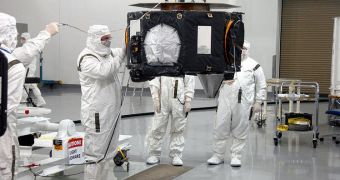Some time ago, the IBEX spacecraft surveying the heliosphere discovered what could best be described as a “ribbon” of energy and particles permeating this protective sheet. Now, experts with the mission finally get some insight into the nature of this ribbon.
The NASA Interstellar Boundary Explorer (IBEX) was launched in October 19, 2008, aboard a Pegasus-XL delivery system, with the express goal of analyzing the boundary between the solar system and the interstellar medium.
This boundary is the area where the protective effects of the heliosphere can no longer be discerned from the background. This protective layer is generated by the Sun, and it envelops the entire solar system, ensuring that galactic cosmic rays do not penetrate towards the planets.
Scientists with the IBEX mission now say that they were able to discover and isolate the ribbon of particles and energy that marks this boundary. Their finding will be detailed in a paper accepted for publication in the April 10 issue of the Astrophysical Journal.
This investigation provides a new view into the fundamental structure of the heliosphere, investigators say, while at the same time proving 40 years of astronomical theory wrong, Space Fellowship reports.
IBEX constructed new maps of the boundary by surveying energetic neutral atoms near the boarders of the solar system. Its ultra-high sensitive cameras were critical for the success of the study.
“Isolating and separating the ribbon from the IBEX maps was like pulling the drapes from our window to discover the landscape at the edge of the solar system,” explains University of New Hampshire associate professor Nathan Schwadron.
The expert, who is the lead author of the new paper, is based at the UNH Department of Physics, and also at the Institute for the Study of Earth, Oceans, and Space.
“These maps are very rich scientifically and are critical in helping scientists understand how our space environment is controlled by the galactic medium” adds Southwest Research Institute (SwRI) expert David McComas.
“They provide the first images of our solar system’s boundaries, which control the access to potentially harmful galactic cosmic rays as well as all other matter from deep space,” he adds. McComas is the lead scientist of the IBEX mission.
“There are many theories about how the ribbon is created, and we don’t understand exactly what we’re seeing but it seems to be telling us something about how the local galactic magnetic field interacts with the heliosphere,” Schwadron concludes.

 14 DAY TRIAL //
14 DAY TRIAL //